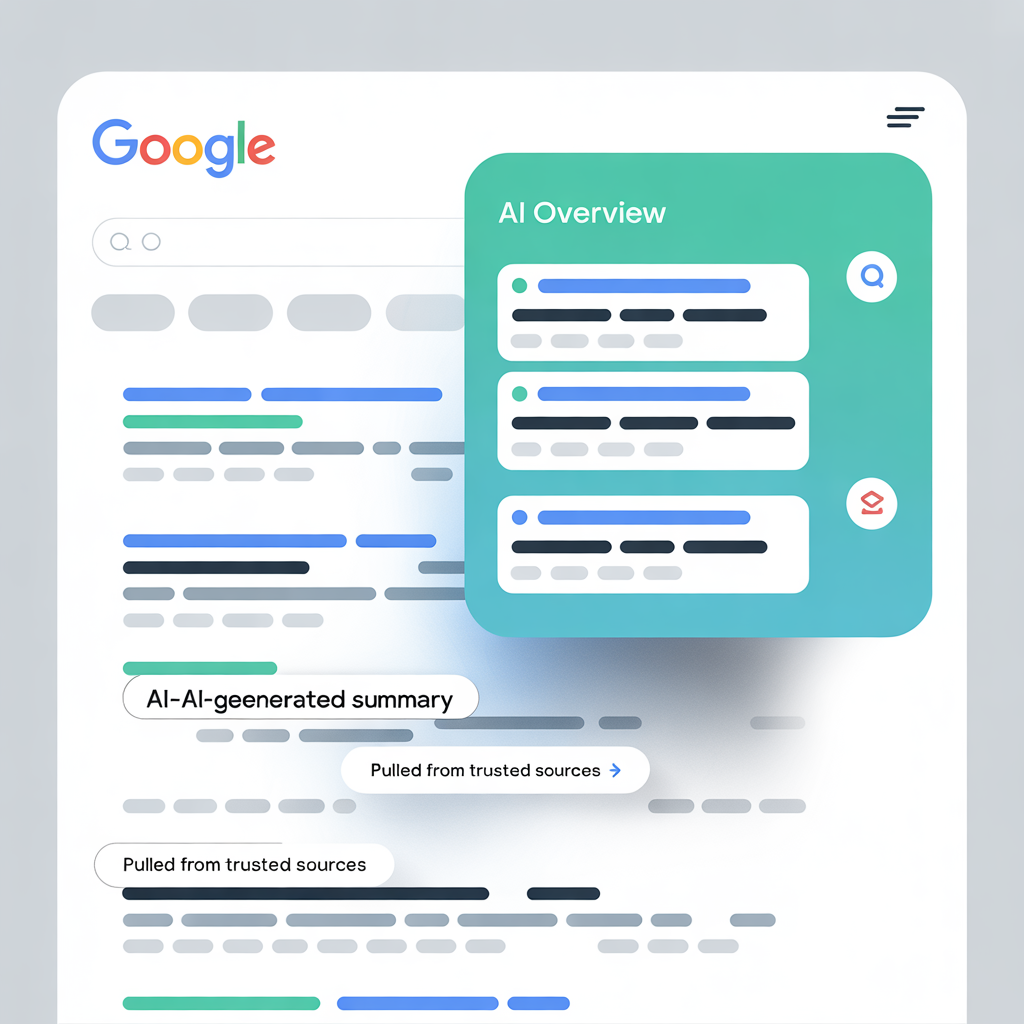By Steve Erickson, AI + SEO Consultant at Evolution Digital Marketing

Last updated: June 2025
The SEO game changed overnight.
Your #1 ranking? It’s worthless if your competitor dominates the AI Overview above you. While you celebrate your position, they capture the trust, the clicks, and the customers.
Welcome to 2025, where visibility trumps rankings every single time. Google’s initial search generative experience was the precursor to today’s Google’s AI Overviews, marking the evolution of generative AI integration in search.
The Brutal Truth About Modern Search
Picture this: You rank #1 for “solar panel installation cost.” Your competitor sits at #5. But their answer appears in Google’s AI Overview—that comprehensive summary box now prominently featured at the very top of the SERP, above all traditional results.
Who gets seen first? Who builds authority? Who wins the customer? AI Overviews display information in a visually distinct way compared to standard listings, making them stand out on the search results page and drawing more user attention.
Not you.
This isn’t theory. It’s happening right now across every industry, every search, every day. Traditional SEO metrics tell you you’re winning while your business slowly bleeds market share to smarter competitors, as the AI Overview at the top of the search results page impacts the visibility of all other results.
What Are Google’s AI Overviews? (The Reality Check)
Google AI Overviews are a new feature in Google Search, introduced to transform the search experience by leveraging generative AI technology. This feature uses generative AI to generate comprehensive responses by pulling key information from across the web. The AI-generated response is designed to deliver key information directly in the search results, often at the top of the SERP. AI Overviews display links to authoritative sources, allowing users to access more details and explore further. This technology enhances and expands the capabilities of Google Search, providing users with quick, relevant answers and improving the overall user experience.
But here’s what blindsided most SEO professionals: AI Overviews don’t simply reward the highest-ranking pages.
They prioritize clarity over authority. Structure over backlinks. Value over domain strength.
Your traditional ranking signals still matter—just not as much as you think. Google’s AI evaluates content through natural language processing. It looks for direct answers. It seeks structured formatting. It demands topical authority demonstrated through comprehensive coverage.
The rules changed. Most businesses haven’t noticed yet.
The Case Study That Changes Everything
Before we dive deeper, let me show you what this looks like in the real world.
AI Overviews now appear at the top of Google Search results, often above organic results. This placement can significantly impact visibility and click-through rates, as users may interact with the AI-generated summary before scrolling to the traditional organic results.
When analyzing why competitors appear in AI Overviews, it’s clear that their content better matches the AI-generated answer. This close match to the user’s search intent is why their sites are selected for inclusion in the AI Overview, highlighting the importance of aligning your content with the information provided by Google’s AI.
Eco Roofing Solutions: From Invisible to Indispensable
John Martinez owned a problem.
His roofing company ranked #1 for “metal roofing installation” and “roof replacement cost.” His SEO reports looked fantastic. His website traffic stayed flat. His leads were declining.
Something wasn’t adding up.
We discovered the issue during manual searches. Competitors with lower rankings were consistently appearing in AI Overviews for his target keywords. Potential customers were getting their answers from other sources, even though Eco Roofing had better traditional SEO metrics.
The fix required a complete mindset shift.
Instead of chasing rankings, we focused on winning AI citations. We optimized the content to satisfy user intent and align with the requirements of AI Overviews. We identified 47 customer questions across their service categories. We restructured existing content using AI-friendly answer formats. We added 30+ strategically placed question-answer pairs across 12 service pages.
We implemented FAQ schema markup on all optimized pages. We connected FAQ answers to detailed service pages for topical authority. We built a hub-and-spoke architecture that demonstrated comprehensive expertise. Ensuring all pages were properly indexed was crucial for being considered for AI Overviews.
While this case study demonstrates the framework, implementing this level of technical complexity requires expertise in both content optimization and AI-specific technical SEO. That’s exactly why we developed our systematic AI SEO optimization approach – to handle the technical complexity while you focus on running your business.
The results spoke louder than any ranking report:
- 68% increase in total search impressions within 90 days
- 3 confirmed AI Overview citations for high-value keywords
- 23% boost in qualified leads directly attributed to AI visibility
- 47% improvement in click-through rates as brand recognition increased
- 6-month sustained growth with continued AI Overview expansion
All of these improvements were part of a broader SEO strategy designed to adapt to the new AI-driven search landscape.
The Owner’s Perspective
“We were ranking everywhere but invisible to customers. After deploying this FAQ system with proper schema markup, our leads jumped 23% in 90 days. Google finally trusts us as the roofing authority in our market. The crazy part? We’re getting calls from people who say they found us ‘at the top of Google’—even though we know they mean the AI Overview, not our ranking.”
— John Martinez, Owner of Eco Roofing Solutions
Why Traditional SEO Metrics Lie
The Eco Roofing case reveals a fundamental truth about modern search: rankings don’t equal results.
Think about your own search behavior. When you Google a question, do you scroll past the AI Overview to click the first organic result? Or do you read the AI-generated answer and move on with your day?
Most users choose the latter.
Google’s internal data supports this shift. AI Overviews receive significantly more attention than traditional snippets. They build trust faster than ranking positions. They answer questions without requiring additional clicks.
This creates a new hierarchy of search visibility:
- AI Overview citations (highest visibility and trust)
- Featured snippets (moderate visibility)
- Traditional rankings (lowest visibility, highest competition)
AI Overviews often appear at the top of the SERP alongside ads, which are clearly labeled and positioned in dedicated slots, impacting user engagement. The rise of AI Overviews has created new opportunities for brands to gain visibility and engagement. Users are now visiting a greater diversity of sources linked within AI Overviews, rather than just clicking the top organic result.
Your #1 ranking puts you at the bottom of this new hierarchy. Your competitor’s AI citation puts them at the top.
The Opportunity Hidden in Plain Sight
Here’s what most businesses miss: AI Overview optimization isn’t more difficult than traditional SEO.
It’s different.
Traditional SEO rewards comprehensive content, authoritative backlinks, and technical perfection. AI Overview optimization rewards clear answers, structured formatting, and direct value delivery. These AI-generated summaries often provide all the information a user needs directly in the search results, making it essential for businesses to adapt.
AI Overviews also encourage users to explore a wider range of ideas and sources, leading to greater diversity in the types of websites and content users engage with.
You don’t need more content. You need better-structured content.
You don’t need more backlinks. You need clearer answers.
You don’t need perfect technical SEO. You need AI-friendly formatting.
The businesses winning this game aren’t the ones with the biggest SEO budgets. They’re the ones who adapted fastest to the new rules.
What This Means for Your Business
Every day you delay AI Overview optimization, you’re handing market share to competitors who understand the new game and have gained access to AI Overview features through Search Labs experiments.
Your customers are searching. Google’s AI, powered by its vast knowledge base and knowledge graph, is listening. Your competitors are answering.
While you focus on maintaining rankings that matter less each month, they’re building the visibility that drives real business results. They’re capturing the trust that converts browsers into buyers. They’re positioning themselves as the obvious choice in your market by adjusting their content and strategies to align with AI-generated summaries.
Google’s AI models are continually improved through training on user interactions and search data, making AI Overviews more accurate and relevant over time.
The gap widens daily.
The Path Forward
AI Overview optimization follows a proven framework, with many new AI Overview features first tested in Search Labs before wider rollout. You can learn this framework, implement it, and leverage each feature to expand and enhance your business’s visibility in search results—provided these strategies are properly implemented.
But success requires understanding the complete system:
- How to identify questions that trigger AI Overviews
- How to format content that wins AI citations
- How to implement the technical foundation properly
- How to track and measure your success
- How to scale your results systematically
This isn’t guesswork. It’s a repeatable process that works across industries, markets, and business sizes.
The businesses that master this framework first will own their markets. The ones that wait will spend years playing catch-up.
Your Next Step
The shift to AI-dominated search results represents the biggest SEO opportunity since Google’s inception. Early adopters win big. Late adopters fight for scraps.
Which category will you choose?
Continue to Part 2: How to Find AI Overview Opportunities →
In the next post, I’ll show you the exact research framework for identifying questions that trigger AI Overviews in your industry. You’ll learn the tools, techniques, and strategies that separate winners from losers in the new search landscape.
Ready to dominate AI Overviews in your market? I help businesses implement proven AI Overview optimization strategies that drive real results. If you’re serious about capturing market share while your competitors figure out the new game, our AI SEO optimization services can help you achieve measurable results in 90 days or less.
Don’t let your competitors win the visibility game while you’re still playing by yesterday’s rules.

